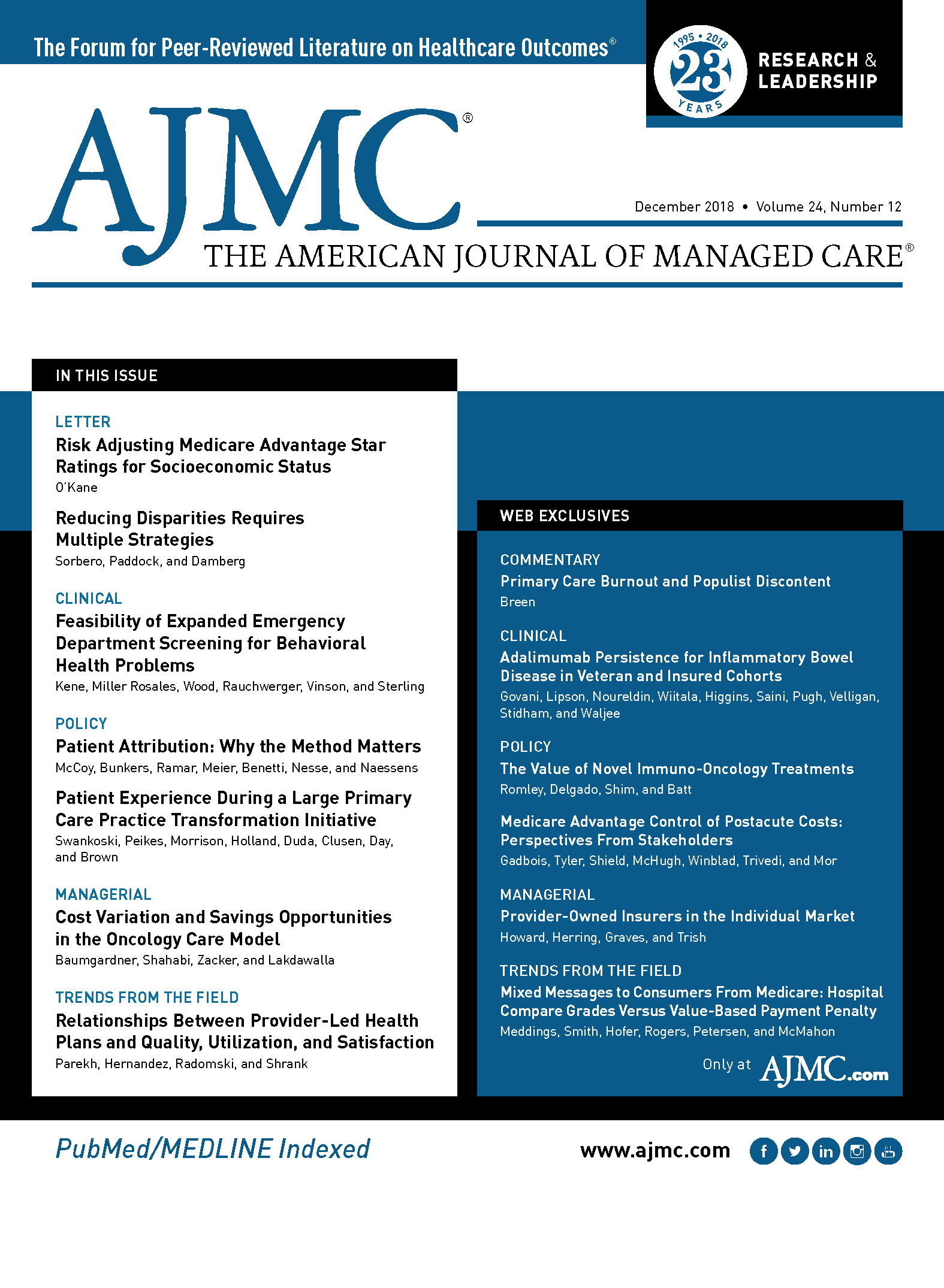- Center on Health Equity & Access
- Clinical
- Health Care Cost
- Health Care Delivery
- Insurance
- Policy
- Technology
- Value-Based Care
Risk Adjusting Medicare Advantage Star Ratings for Socioeconomic Status
The National Committee for Quality Assurance urges socioeconomic risk adjustment to payments, not quality measures.
Am J Manag Care. 2018;24(12):566The National Committee for Quality Assurance (NCQA) strongly disputes the suggestion that Medicare should adjust Medicare Advantage (MA) star ratings measures for socioeconomic status (SES).1
It is true that plans with large low-SES patient enrollment perform worse on some measures—on average. However, this association does not prove causation. Some plans with large low-SES populations (more than 75% dually eligible) perform well above average on key Healthcare Effectiveness Data and Information Set measures. These include breast and colon cancer screening, treatment of high blood pressure and rheumatoid arthritis, diabetic blood sugar control, and osteoporosis testing.2 The Figure shows the array of breast cancer screening measure scores among plans by the percentage of dually eligible enrollees in each plan. Some plans with more than 75% dual enrollment nonetheless are above the 80th percentile on their performance. These plans perform well because they understand they can do so, regardless of patient income, by delivering person-centered care.3,4
More importantly, adjusting quality scores for SES merely masks disparities in care without doing anything to address disparities. This unfairly locks in lower expectations for the populations that are most in need of better quality.
There are much better ways to address disparities that do not mask very real differences in quality. First, Medicare should adjust base payments to MA plans for enrollee SES—and has done so since 2017—which gives plans with low-SES enrollees the resources to meet these patients’ greater needs.5 Adjusting base payments, rather than quality measures and the bonuses based on them, does not mask disparities or falsely dismiss them as something that plans cannot address. Second, NCQA is stratifying results by SES for measures with persistent SES-related disparities. Stratification highlights where plans need to focus to reduce and ultimately eliminate disparities.6 Third, sharing best practices of plans and providers who achieve good outcomes in lower-SES populations also helps address disparities.Author Affiliation: National Committee for Quality Assurance, Washington, DC.
Source of Funding: None.
Author Disclosures: The author reports no relationship or financial interest with any entity that would pose a conflict of interest with the subject matter of this article.
Authorship Information: Concept and design, analysis and interpretation of data, and supervision.
Address Correspondence to: Margaret E. O’Kane, MHA, National Committee for Quality Assurance, 1100 13th St NW, 3rd Fl, Washington, DC 20005. Email: okane@ncqa.org.REFERENCES
1. Sorbero ME, Paddock SM, Damberg CL, et al. Adjusting Medicare Advantage star ratings for socioeconomic status and disability. Am J Manag Care. 2018;24(9):e285-e291.
2. O’Kane ME. NCQA comments on advance notice of methodological changes for calendar year 2016 for Medicare Advantage call letter. National Committee for Quality Assurance website. ncqa.org/comment-letter/ncqa-comments-on-advance-notice-of-methodological-changes-for-calendar-year-2016-for-medicare-advantage-call-letter/. Published March 6, 2015. Accessed September 12, 2018.
3. Berenson J, Doty MM, Abrams MK, Shih A. Achieving better quality of care for low-income populations: the role of health insurance and the medical home for reducing health inequities. The Commonwealth Fund website. commonwealthfund.org/publications/issue-briefs/2012/may/achieving-better-quality-care-low-income-populations-roles. Published May 16, 2012. Accessed September 12, 2018.
4. Markovitz AR, Alexander JA, Lantz PM, Paustian ML. Patient-centered medical home implementation and use of preventive services: the role of practice socioeconomic context. JAMA Intern Med. 2015;175(4):598-606. doi: 10.1001/jamainternmed.2014.8263.
5. CMS finalizes 2017 payment and policy updates for Medicare Health and Drug Plans [news release]. Baltimore, MD: CMS; April 4, 2016. cms.gov/newsroom/press-releases/cms-finalizes-2017-payment-and-policy-updates-medicare-health-and-drug-plans. Accessed September 12, 2018.
6. Accounting for socioeconomic status in HEDIS measures. National Committee for Quality Assurance website. ncqa.org/hedis/reports-and-research/hedis-and-the-impact-act. Accessed September 12, 2018.

Trends in Hospital Pricing for Vulnerable Emergency Department Users, 2021-2023
December 4th 2025Self-pay emergency department prices rose significantly from 2021 to 2023, especially at for-profit and system-affiliated hospitals, highlighting growing affordability challenges for uninsured and underinsured patients.
Read More
Integrated Care for Chronic Conditions: A Randomized Care Management Trial
December 3rd 2025The authors sought to understand the differential impact of payer-led community-based care management approaches on stakeholder-oriented outcomes for publicly insured adults with multiple chronic conditions.
Read More

